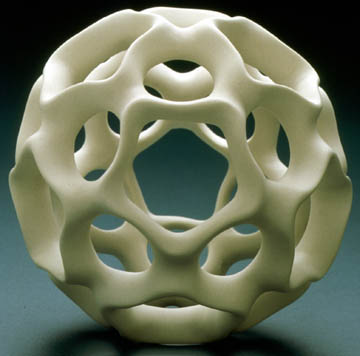by Bobby Jaber with Bonnie DeVarco


"Hildegard de Bingen,"
approximately 5 inches in diameter, carved porcelain, fired to Cone 8
My work brings together in three dimensions the same rhythmic, symmetrical elements that define the beautiful works of Islamic art. Historically, Islamic artists applied mathematics to tile patterning because their work could contain no graven images. I wanted my finished works - vessels that introduced curvature to the embedded design - to bring a new dimension to the geometric art experience, one that was both natural and abstract at the same time. But unlike traditional Islamic design, and as an homage to the latter half of 20th century science, I also wanted to combine chaos with order into a symmetrically unified "whole."
Drawing from my experiences with science, I injected rigor and documentation into the artistic process. Using color-coded graphs and information logged into a journal, I recorded the evolution of each design (http://www.porcelainia.com). The early days were filled with experimentation as I tried many different approaches. Working out most of the technical problems allowed these spherical forms to become larger, more complex and intricate.
ABOUT CONTACT CREDITS 2000 GALLERY